8 kilometer
200 m altitude
5 Stations
1 lunch
1 boat cruise
Tüürli Interlaken: Hike, degust and indulge. a perfect excursion for friends, families and companies.
Hike under your own steam through the breathtaking scenery of the Holiday Region Interlaken and discover the untamed side of Switzerland. At five different stopping points, enjoy exclusive beers and wines from around the region. Another culinary highlight awaits as a lunch at the “Oberländerhof” restaurant in Bönigen. The stunning views of turquoise Lake Brienz combined with the delicious drinks are sure to delight.
8 Kilometer
The Tüürli leads along the Aare river and across the lake of Brienz, through villages and forests
200 m altitude
From the lake of Brienz to the Burgseeli, 200m of altitude are conquered
5 Stations
A wine and a beer are presented at each of 5 stations. You will also learn exciting facts about the region and its history
1 Lunch
The lunch in the restaurant "Oberländerhof" in Bönigen is included.
1 boat cruise
By boat from Bönigen to Ringgenberg.
Hier klicken
directions
1) Youth Hostel After you have enjoyed your welcome drink (you can also take it on the way) take it on your way), leave the Youth Hostel and walk to the right. turn right, then turn right again under the railway tracks and under the railway tracks and to the Aare. Follow the Aare until you reach Lake Brienz. Lake Brienz and then walk to the lido at Bönigen. 2) Strandbad Bönigen Here you can pick up your second drink. After that it’s not not far from there, over the Lütschine and up to the lakeside road to the Oberländerhof restaurant. 3) Oberländerhof You will receive the “Tüürli-z’Mittag” and a drink (beer and/or wine) in return for handing in the coupon, non-alcoholic). Please note the departure time of the boat to Ringgenberg (14.25 hrs)! You must not miss it. You should be ready at the landing stage at least 5 minutes before departure. You will leave the boat at the next stop. If you If you miss the exit, there’s no way back. 4) Burgseeli After leaving the boat, follow the ascending hiking trail to the left in the direction of Ringgenberg. After the church turn left. You come to Brandstrasse, which you follow to the end. In the forest turn right up the hill and then down again to the Burgseeli. to the Burgseeli. 5) Riverlodge Leave Burgseeli the same way you came in and go back to the hiking trail. back onto the hiking trail. At a slightly higher level, walk along the Burgseeli in the direction of Interlaken. Go down through the forest to Goldswil. If you now follow the right bank of the Aare, you cannot miss the Riverlodge. the Riverlodge. You can help yourself to the fridge under the pavilion. Please put the coupon in the till and for each additional drink, put the corresponding amount in the or twin for each additional drink. Please return the glasses and bags to the Youth Hostel staff and take the deposited ID with you.1) youth hostel
Interlaken Ost international railway station The Interlaken Ost railway station is a symbol of Interlaken’s international importance and links. There is a direct Intercity connection from Hamburg to Interlaken Ost. Other major European cities and tourist destinations such as Paris, Milan and Berlin can be easily reached by changing trains once. Interlaken is therefore a popular stop for many tourists on their European trip.
Ships before the railway in the Bernese Oberland
Ships were on course in the Bernese Oberland much earlier than the railway. In 1834, the Knechtenhofer brothers laid the foundation stone for excursion shipping on Lake Thun. To liven up their hotel in Thun, the Knechtenhofer brothers ordered an iron 16-horsepower steamboat in Paris in 1834.
From then on, shipping on Lakes Thun and Brienz connected the local population with the rest of the world and laid the foundation for modern tourism in the Bernese Oberland. Stagecoaches and carts carried travellers and goods to Thun, where steamships were used to continue the journey to Interlaken. At that time, the Hofstetten-Neuhaus route took about 75 minutes without a stopover. From Interlaken-West (Neuhaus), the journey continued on the road to Bönigen, and then changed to the Lake Brienz ship. That was the so-called Belle Epoque! “Far too grand a project” – connection between Lake Brienz and Lake Thun rejected
During this period, the hotelier and pioneer Knechtenhofer had a plan drawn up for a continuous shipping canal between Lakes Thun and Brienz to present to the then newly founded shipping company. The construction costs of this canal, for which a chamber lock and a stop on the Höhenmatte in Interlaken were planned, were calculated by Lanicca at about 650000 Swiss francs old currency (about 930000 Fr. n. W.). However, the project was rejected by the new company as being too far-reaching, far too grandiose.


Escapade - Spiezer Alpine Weinkultur
The wine cellar where the wines are produced is located within the walls of Spiez Castle, the oldest parts of which date back to the 10th century. The wine tradition on Lake Thun also goes back that far. Although abandoned in the meantime, it was revived by a few enthusiasts at the beginning of the last century. They founded an association, which was converted into a cooperative in 1942. Today, around 120 cooperative members are behind the idea of promoting and preserving the cultural heritage of vines and wine in Spiez. Some of them lend a hand with the harvest, others organise tastings, help with events, show their friends the vineyard or simply open a bottle of Spiezer with like-minded people. The wines are presented in three lines: Lake, Mountain and Summit.
They are complemented by the wines of the lake and mountain friends, the so-called Freunde Weine. Together with friendly winemakers from the Jura and the Alps who believe in the same quality and high standards, Spiezer Alpine Weinkultur produces expressive wines, for enjoyable moments with friends. This results in well-balanced, multi-layered quality wines that are ready to drink, made from both their own grapes and the grapes of friends. The Cuvée “Escapade” also belongs to this line. What actually is a cuvée? The word “cuvée” comes from the French “cuve”, which means vat or wine container. In the original sense, it meant a certain amount of wine, actually a barrel of wine. Today, the term stands for a blend of several wines from different grape varieties or vineyards. But because “blend” sounds so technical, almost painful, in German-speaking countries we like to use terms from other countries, such as Cuvée, Assemblage or Mariage. The aim is for the blended wine to taste better than each batch on its own. The aim is to achieve a harmony of alcohol, aromas, acidity, tannins and colour by using different grape varieties. Bouquet: Yellow fruity hints, lemon balm and citrus notes. Palate: Very fresh, considerable length and mouth-filling. Wine and food: Apéritif, pumpkin dishes, vegi, sea fish, Asian & fusion cuisine. Grape varieties: Riesling-Sylvaner, Viognier, Sauvignon Blanc, Kerner.
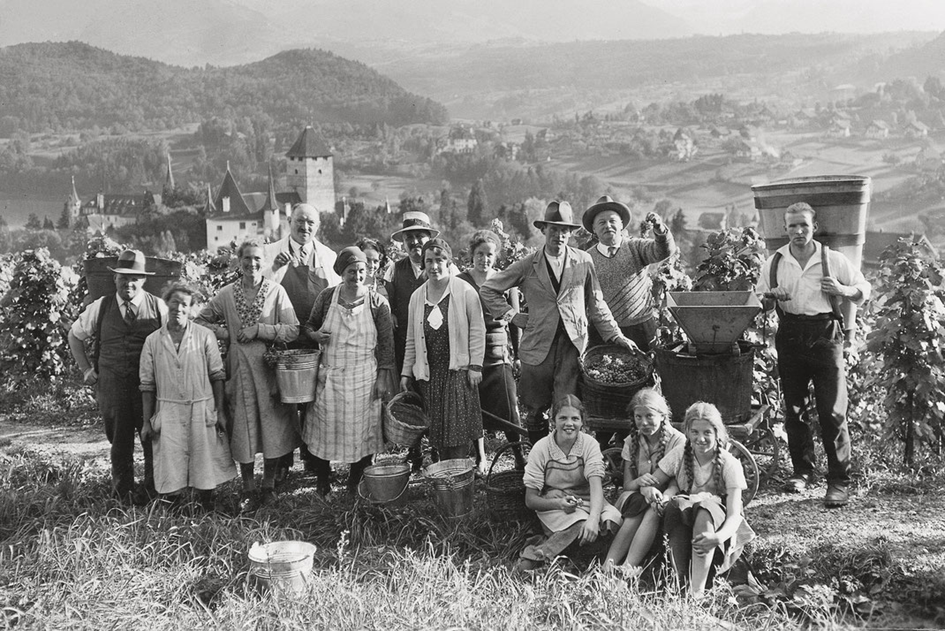

Harder - Rugenbräu
In 1866, the councillor Christian Indermühle from Kiesen founded the Indermühle brewery and distillery on the Gasthausmatte of the Hotel Interlaken inn. After his death, his sons took over the brewery, but had to sell it due to financial constraints. The Bavarian brewmaster Joseph Hofweber (*1845) took over the brewery and built the brewhouse on the Rugen. At that time there was a second brewery on the “Bödeli”: that of Emil Horn. During the First World War, J. Hofweber & Cie. AG decided to merge with Emil Horn. In 1935, the general partnership J. Hofweber & Cie. AG and Horn Bros. was formed. In 1968, this became the joint-stock company Rugenbräu AG. The brewery is still owned by the Hofweber family today. Andrea Dähler-Hofweber is the president of the board of directors. What is a bock beer?
Bock beers belong to the group of strong beers. To be allowed to call a beer “bock beer”, it needs an original wort of at least 16 %. The more malt is used in brewing, the higher the original wort content. The original wort is the proportion of dissolved substances in the beer brew before fermentation. This includes mainly sugar, but also vitamins, minerals, protein, aromatic substances or malt substances. This results in a high alcohol content, which can be between 6 and 12 percent. Whether it is a top-fermented or bottom-fermented beer, whether it is light or dark, is not clear from the name Bockbier. The name only refers to the original wort. Bock beers taste much more intense than normal beers. They serve less to quench thirst than to be enjoyed. So you don’t gulp down a bock beer, but drink it slowly. Harder beer: The bottom-fermented bock beer with round malt aromas and a hint of sapphire hops, accompanied by a pleasant bitterness. Alcohol content: 7.2 % vol. Bitterness unit (IBU): 25 – 30
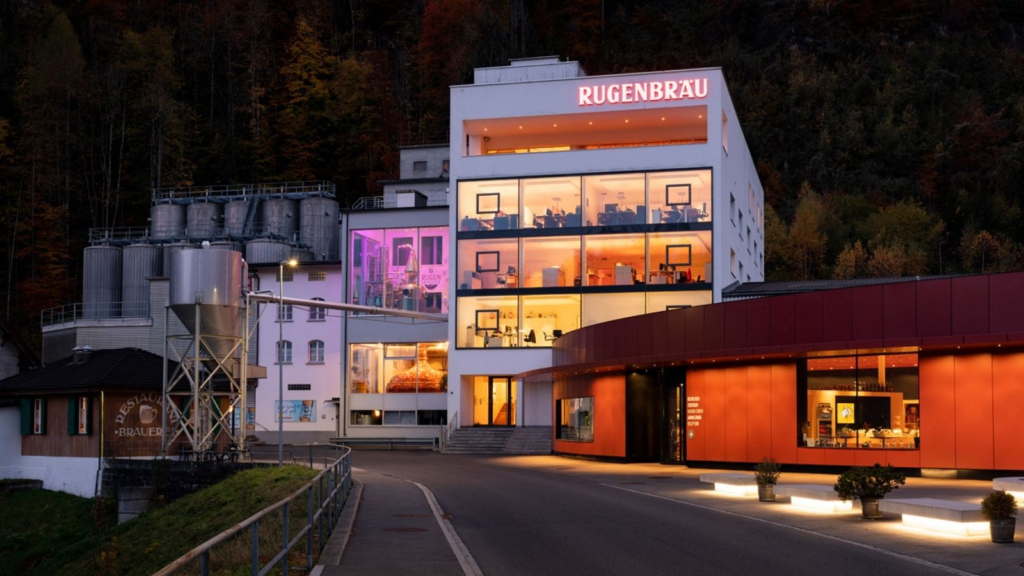

2) Strandbad
“Wendelsee” Lakes Brienz and Thun were formed from a single large lake: Lake Wendel stretched between the present-day villages of Meiringen and Uttigen. It was formed by the retreat of the Aare glacier after the last ice age about 10,000 years ago and was flowed through by the Aare. Over the years, the accumulation of debris from the Lütschine and the Lombach created the “Bödeli” roughly in the middle. The complete separation into two lakes, Lake Brienz and Lake Thun, is documented to have been completed around the year 1000, but it was probably complete earlier. Turquoise colour Lake Brienz is world-famous for its turquoise colour. One reason for this colour is the river Lütschine, which you will cross on the way to the next station. The Lütschine rises in the valleys of Grindelwald and Lauterbrunnen. They are fed by glaciers and therefore contain a lot of sediment, which leads to the grey-light colour of the river. Mixed with the blue lake water, it then turns turquoise. Incidentally, the name Lütschine comes from the Celtic name leucos, leuca, which means “white” or “bright, shiny”. Fishing used to be essential for the inhabitants of Bönigen and most of the other villages on the lake. Today there is only one professional fisherman left on Lake Brienz. And even he still works 70% on another job.
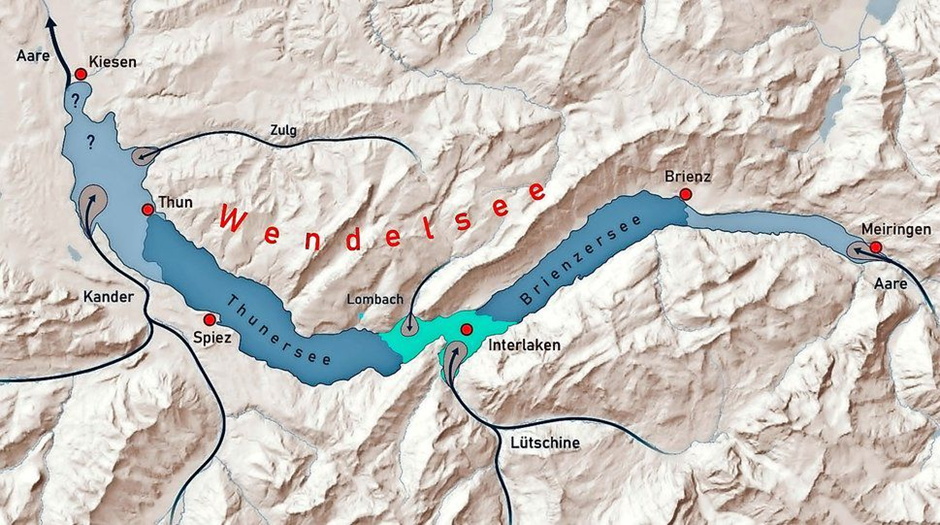
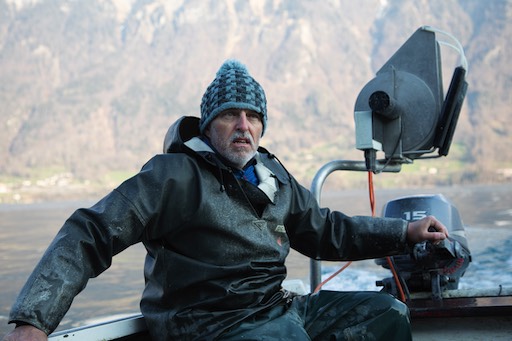
Chasselas - Le Baumli
This is the story of a young pair of winemakers and oenologists. The two oenologists wanted to start their own winery in the Lake Biel region. A region chosen for its typical wine-growing area, its breathtaking scenery and above all for its diversity. Unfortunately, neither of them owned a family estate. A long road full of challenges awaited the two. But in the end, with a bit of luck, Stéphanie Horger and Marvin Aebischer were able to settle in Tüscherz. To their good fortune and to that of the wine. The King Grape Chasselas The heart of Swiss viticulture is the Chasselas grape (also called Gutedel or Fendant). Chasselas is the most widely cultivated grape variety in Switzerland, where it accounts for about 40% of the total vineyard area.
Unproblematic in cultivation and a sure value in yield, Chasselas is a diva in the cellar. It does not forgive any mistakes.
In cultivation, the Chasselas is tricky. The fresh shoots are sensitive to wind breakage and both the foliage and the grapes are susceptible to fungal diseases. If the flowering takes place in unfavourable weather, the Chasselas tends to trickle (unfertilised berries fall off). On the other hand, if flowering is good, an impressive yield must be expected. Yield regulation is therefore a must with this grape variety. In the early 1980s, the Valais and Vaud were literally drowning in Chasselas due to overproduction. The philosophy of “mass instead of class” led to unimagined logistical problems in the 1980s: Leftover, unsaleable Chasselas even had to be stored in public swimming pools. Today, a lot of Chasselas is still produced, but one with a lot of profile and class. The variety, which has a restrained flavour of its own, reacts strongly to the influence of the place where it is grown. What we like about Chasselas is its rather neutral, delicate aroma, which reflects the different soils or climatic conditions of the individual wines.

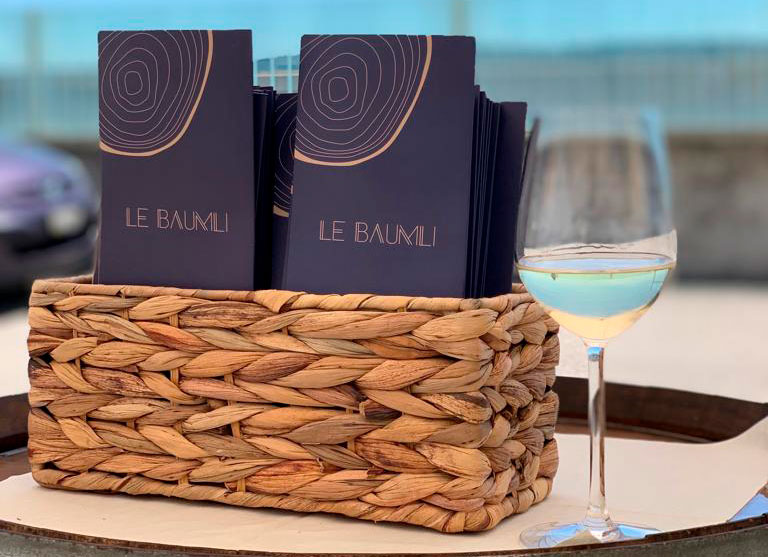
Kama Citra - Haarige Kuh
The Hairy Cow Brewery is an independent craft brewery based in Interlaken, Switzerland. Andrew Taylor and Glynn Gillies are both from Scotland and started making their own beer in Interlaken in 2015. First in the kitchen, then in the garage and now in their own brewery, the two are always tinkering with new beers and have made a name for themselves in Switzerland. Inspired by the craft beer scene in the USA and Great Britain, they now brew a wide range of beers from IPAs to sours. All beers are unfiltered, unpasteurised and unfined, maximising flavour, aromas and consistency. UPPER BEER AND LOWER BEER: Which is which? In fact, there are well over 100 different styles of beer. However, in general, all these beer styles are divided into two groups – “ale” and “lager”. Translated into German, this means top-fermented and bottom-fermented. Ale is top-fermented beer, lager is bottom-fermented. Whether a beer is top-fermented or bottom-fermented depends on which yeast it was fermented with. Top-fermenting yeasts prefer to convert sugar into alcohol at warm temperatures, bottom-fermenting yeasts work at cold temperatures. Ales are beers that are fermented with a top-fermenting yeast. It floats on the surface of the beer (on top!). e.g.: Pale Ale, IPA, Stout and Porter, wheat beer. Lagers are beers that are fermented with a bottom-fermenting yeast. It falls to the bottom during fermentation, collects at the bottom of the tank (bottom!). e.g.: Pilsener, Helles, Märzen Kama Citra Beer: A single hop Pale Ale that is full of tropical fruit flavours due to the addition of Citra hops and cold hopping. Alcohol content: 5.0 % vol. Bitter Unit (IBU): 28 Original wort: 11.0° Plato
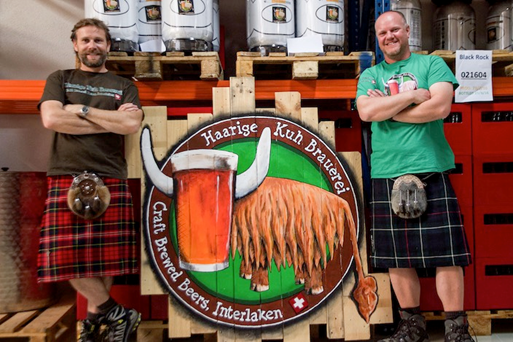
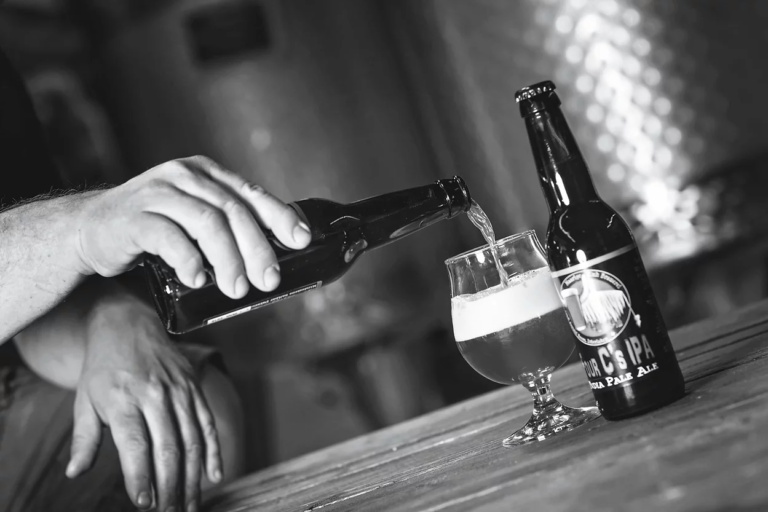
3) Oberländerhof
“Gateway to the narrower Bernese Oberland”. At the end of the 19th century, Bönigen was to have become the gateway to the narrower Oberland. At least that was the speculation of the shareholders of the Bödeli Railway (BB), who built the section from Interlaken Zollhaus (Interlaken Ost) to Bönigen and, in order to beat the shipping companies to the punch, also built the Bönigen shipping port. But things turned out differently. Interlaken Ost became a traffic hub and the Bödeli Railway to Bönigen was hardly used. The closure became an issue.
The idea of no longer being directly connected to the international rail network caused many Bönigen residents’ tempers to flare. In a community meeting attended by 255 voters in March 1966, the Bönigen community council was instructed to campaign vigorously for the railway to remain in operation – unsuccessfully. Fifty years ago, on 31 May 1969, operations ceased and the facilities on the section from the BLS workshop to Bönigen were gradually demolished. The station building also fell victim to the excavator. Today nothing of it is visible.
These circumstances have led to Bönigen today being appreciated by its residents and guests as a pearl, not as well known as Interlaken but at least as picturesque thanks to its lake connection. “Andresler” – A custom and its possible origin On 30 November, the people of Bönig celebrate the “Andresler+”. There are no reliable historical sources on its “origin”.
Paul Michel explained the custom by saying that for many a less well-off family, this day was not a day of joy if they did not have the necessary interest ready – 30 November was rent day. So relatives and friends would have had to help out with the interest. In the course of time, it became customary for the children of poorer people to go in groups from house to house on this day at nightfall to ask for gifts in kind. In return, they would sing a song or recite a poem. Ernst Mühlemann, on the other hand, derives the hustle and bustle from the “cheese feast” – a merry day with food and drink – which the bailiff of Interlaken spent with his countrymen on 30 November.
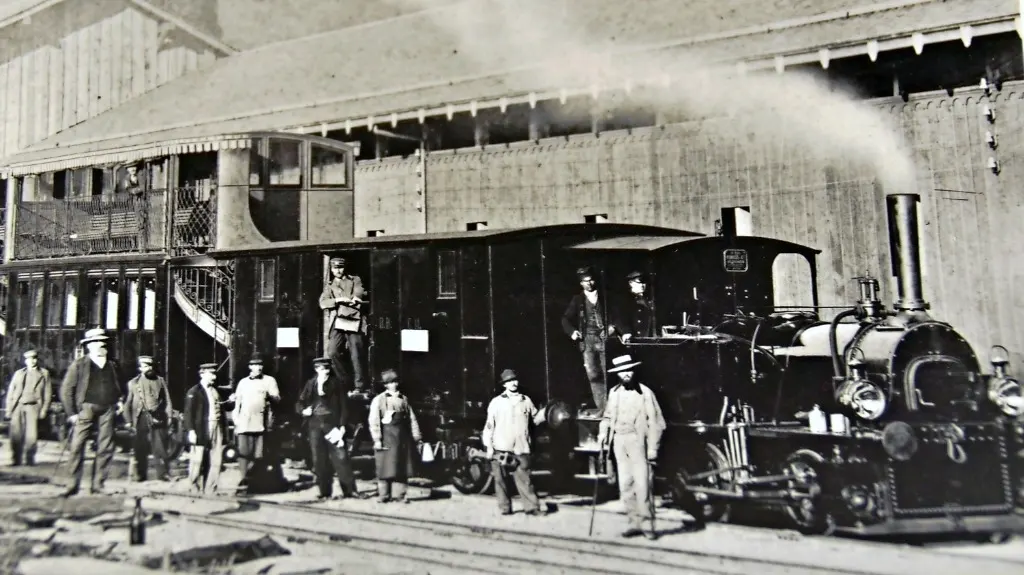

Réflexion - Andreywein
Andreywein is a typical family business in Ligerz on Lake Biel. The brothers Gabriel and Silvan Andrey are the 5th generation to run the winery. In harmony with nature and the beautiful landscape, they cultivate their vineyards with a lot of passion and heart and soul. They grow numerous classic and young grape varieties on 15 hectares. Our vineyards are spread over the municipalities of Ligerz, La Neuveville (Schafis), Twann and Le Landeron. Réflexion Pinot Noir: This elegant and fruity Pinot Noir is harvested by Gabriel and Silvan with his team from specially selected sites. It is then matured in large old oak barrels (3,600 litres), which have been in use for three generations. Her great-grandfather commissioned the barrel and it still stands in her grandfather’s cellar. The idea was to give the Pinot Noir more time and let it rest in it until the next autumn, i.e. for a whole year. This creates the subtle wood note that unites the impressively round character with the strong raspberry note. It is an innovative approach to a traditional method of pressing. Bouquet: Subtle woody note, raspberry and sour cherry. Palate: Fruity attack, smooth, round and fresh. Wine and food: Pairs perfectly with aperitifs or barbecues Grape varieties: Pinot Noir
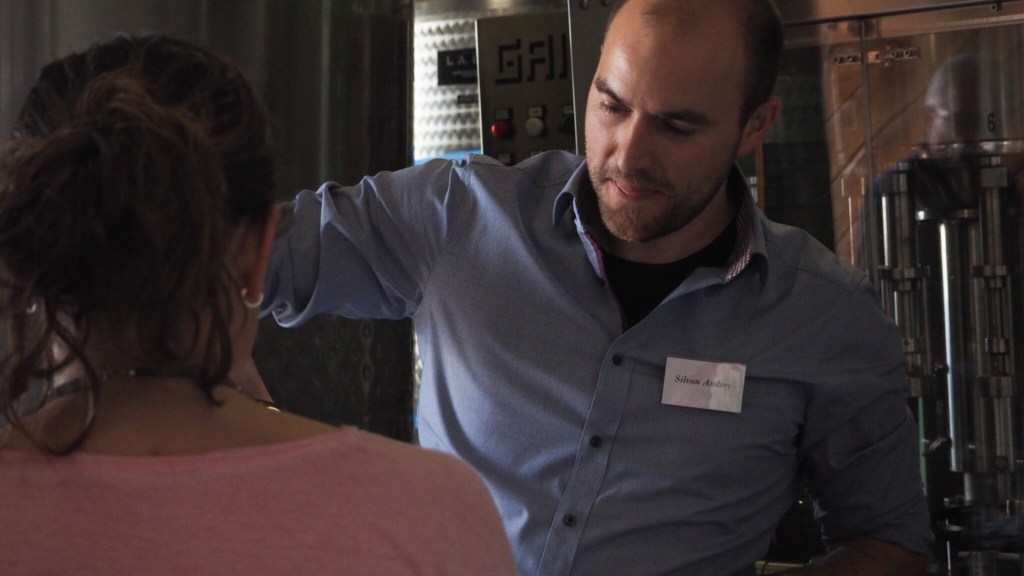
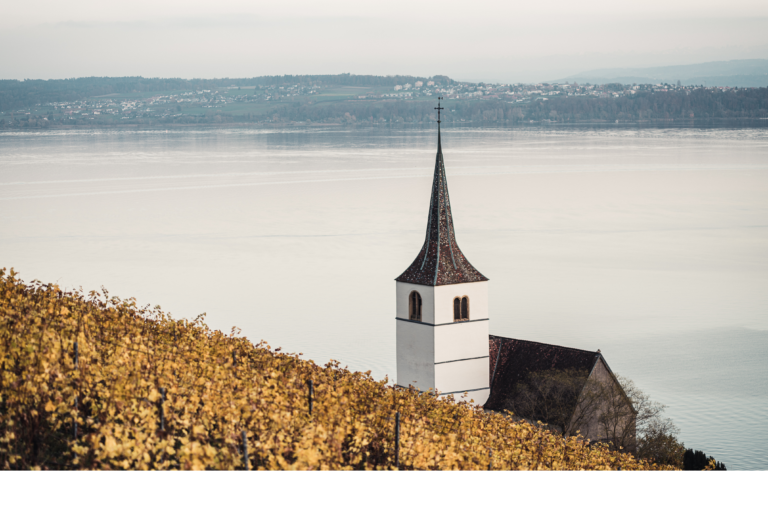
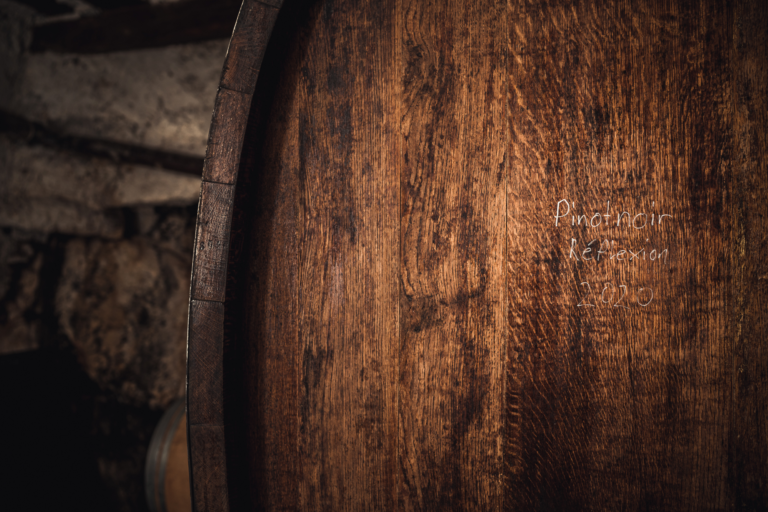
Amber - Rotmoos Bräu
Reini decided to brew his own beer back in 2005. He was inspired by microbreweries and private breweries in Bavaria. In Switzerland, he was among the first microbrewers at the time.
In the beginning, his wife Marlyse supported him and the first beers were already well received by family and friends. They therefore decided to expand the range. In 2008, Björn met Reini’s daughter and with her the beer of the house brewery. He fell in love with both of them and Reini could count on his support from then on. The two decided to register the MarRei brewery with the Directorate General of Customs. Since then, demand has been growing and so has the product range. In 2015, the two learned that their previous brewery was being dismantled by Amasuisse in Bönigen. They finally found a new place to stay at the Cementwerk in Därligen. What are craft beers? There is no clear definition of what is meant by “craft beer”. But tendencies and trends can give an idea of what is meant by it: – Craft brewing, small breweries: Craft brewing with passion, careful and sometimes hand-picked selection of ingredients. – Beer diversity: A desire for diverse beers, a wide variety of beer styles and brewing recipes, local and foreign beer ideas are the model for craft brewers. – Creativity and experimentation: Different varieties of malt and hops are combined to achieve a special taste. New brews are constantly being made, new creations tried out, discarded or brought to a marketable product. – Character: every craft beer has its own character – some like it, others don’t like it at all. – Price: a significantly higher production price entails a correspondingly higher retail price, often double or triple. Amber Red Moss: It gets its brownish-red colour, reminiscent of amber, from a blend of six different types of barley malt. Alcohol content: 5.5 % vol.

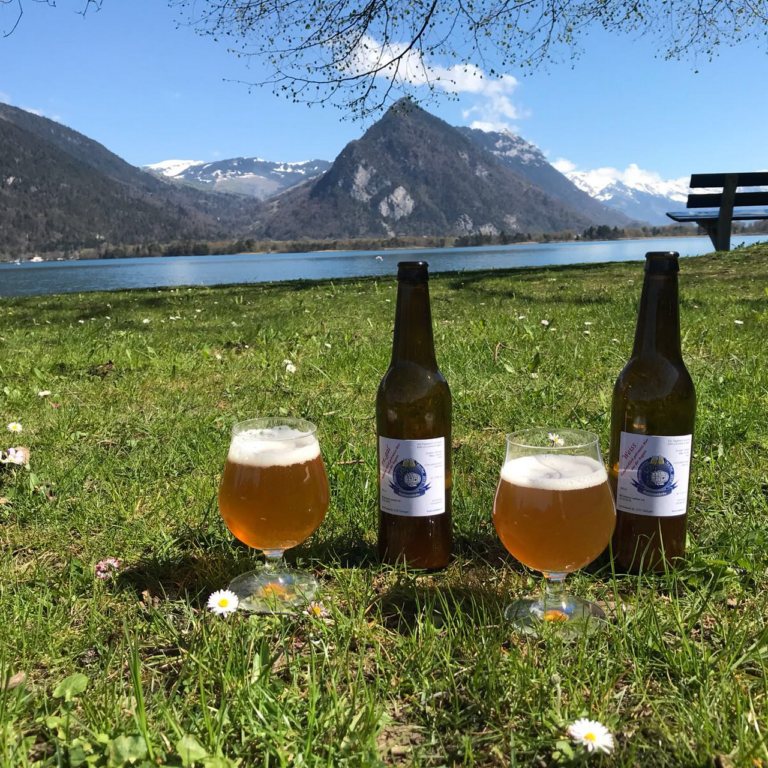
4) Burgseeli
From the Fuleseewli to the Burgseeli The romantic Burgseeli lies quietly and enchanted between the two villages of Ringgenberg and Goldswil. The Burgseeli used to be called Fuleseewli. However, the name, which translates as lazy lake, was not exactly attractive, so it was renamed.
Ice used to be cut out of the lake for the beer brewery. At a time when there were no refrigerators, ice was extracted for the brewery at the shadiest spot near the former Zeigerhüsi in Hondrich. Until the 1940s, locals sawed the thick layer of ice from boards with halved forest saws and transported the ice sticks on sledges to the ice cellar. Watch fire The 17th century was a turbulent time. For example, there was the 30 Years’ War, religious disputes or plague marches. “During this time, watch fires from Bern warned of danger. The warners from Ringgenberg-Goldswil orientated themselves on the watch fire from Aeschi. They themselves then warned the people of Brienz, and from there they went on to the Hasli.

Indian Summer - Murmure du vent
The lateral entrants Martina Christen and Christoph Riesen planted their first vines in 2014. The vineyards are located high above Lake Biel, above Alfermée and Tüscherz as well as in Twann and are now spread over 2.4 ha. The vinification of wines with character is the top priority for Martina and Christoph. In the cellar in Meikirch, the grapes are pressed gently and purely by hand. Without exception, without fining and without filtration, and increasingly in spontaneous fermentation. They work in the vineyard and in the cellar according to the strict guidelines of Bio Suisse and Demeter.
When planting new vines, Martina and Christoph focus on new grape varieties, the so-called fungus-resistant grape varieties (PIWI). The “Indian Summer” is a fruity cuvée of Pinot Noir and the PIWI grape varieties Cabernet Jura, Regent and Léon Millot. Fungus-resistant grape varieties (PIWI): Viticulture relies heavily on plant protection products in the form of chemical or biological agents (fungicides). Without the regular use of these “repellents”, high-quality wine production would not be possible. This applies to both conventional and organic viticulture. PIWIs are the true heroes among the grape varieties. They do not need these constant “repellents” because they are naturally robust against fungal diseases.
Martina and Christoph are concerned about protecting the climate and therefore rely on PIWI grape varieties. The indirect contribution to environmental protection is considerable. The reduced need for plant protection products saves resources that would otherwise have to be used for the production of fungicides. In addition, energy and CO₂ emissions are saved that would be consumed in the production of plant protection products and the application of these products in the vineyard. The result is reduced machinery and fuel use in the vineyards.


Ringgenberg - Burgbier
The idea to brew their own beer came to the two colleagues Hans and Reto on a camping site in the Valais. The two have known each other since church instruction. Both grew up in Ringgenberg and both now work for the police. Brewing beer serves as a contrast to their everyday working lives and their passion for brewing drives them to keep coming up with new creations. The two are supported by their wives. In their free time and with a lot of heart and passion, they create beers in the Burgbier brewery that the village is proud of. Only the best ingredients go into the brew pots and there is something for all beer lovers in the range: whether light or dark, hoppy or malty, fruity or sour. Malt – the soul of beer Malt is processed and dried grain for beer production. Almost any grain can be processed into malt. The best-known cereals for beer production are barley and wheat. Malt is basically grain that has been brought to germination. The malting process is divided into three stages: steeping, germination and kilning. First, the grains are soaked in water for one to two days. In this way, the grain soaks up water and germination begins. Drying, i.e. drying the grain under heat, makes it durable and stops the germination process. The higher the drying temperature, the darker the beer. The starch of the grain is essential for brewing beer. But it cannot be utilised in its raw state. The germination process triggered during malt production creates enzymes in the grain that make starch and protein processable and soluble. At the same time, flavour and aroma substances are formed. Malting produces malt sugar, which can be broken down and fermented by the yeast so that alcohol and carbon dioxide are added to the beer. Malting is therefore a central step in the brewing process. Burgbier Ringgenberg: Lager Hell Alcohol content: 4.6 % vol. Bitterness unit (IBU): 20

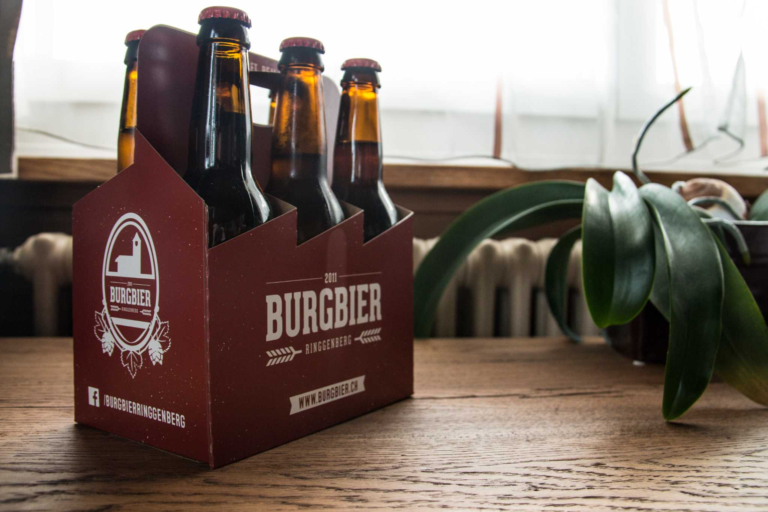
5) Riverlodge
Harder and Hardermannli You are at the foot of the Harder, Interlaken’s local mountain. Many years ago, a monk was once walking on the Harder when his eyes suddenly fell on a beautiful young girl collecting firewood. He followed her and of course she noticed at some point. She became more and more afraid of this old, creepy monk who was following her and finally knew no other way out of this situation than to jump off a cliff. She died and the heavenly court decided that the monk must stay in that mountain for the rest of his days as punishment. To this day, he is literally carved into that mountain.
He is now a symbol of Interlaken and also a kind of patron saint. Every year on 2 January, the evil spirits of winter are driven away at the “Harder Potschete” and people mask themselves with wooden masks. The main character is the Hardermannli. THANK YOU AND GOODBYE We hope you enjoyed the Tüürli and that we will be able to welcome you again soon. Be it in Interlaken, Unterbäch or on the Belalp. You can find all the Tüürlis on our website. You can find more great experiences in and around Interlaken on the website of the Interlaken Tourism Organisation (www.interlaken.ch). Finally, we are happy to receive any kind of feedback on Google, Instagram or by email. Cindy&Jan

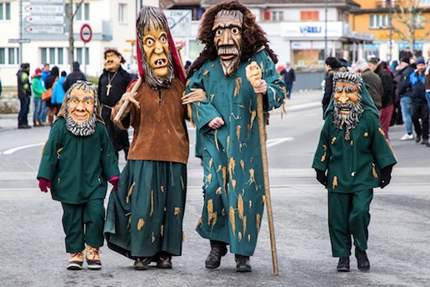
Oeil de perdrix - Johanniterkeller
Martin Hubacher is passionate about getting the best out of the soil, climate and vines. He has been running the Johannitergut together with his wife, Michaela Gabriel, since 1996. Numerous awards and considerable media coverage confirm what connoisseurs have long known: Johanniterkeller can count itself among the best addresses in the region. In 2018, Martin was named Bernese Winemaker of the Year. In 2021, the award SWISS WINWERY OF THE YEAR went to the winery. A highlight and a nice award for the whole team. A successful product is always the result of teamwork. Antonio Damião and Nuno Brízido contribute great know-how and decades of experience in dealing with vines. The two Portuguese bring a touch of Mediterranean savoir-vivre to Twann’s down-to-earthness. In 2018, Johanniterkeller brought wine engineer Mélanie Gigon on board as reinforcement. Every autumn, the winery can also rely on a tireless and loyal harvest crew. What is a Œil de Perdrix? The Œil de Perdrix, French for “partridge’s eye”, is a speciality from the canton of Neuchâtel. This name was chosen because its colour resembles the iris of the partridge. It is a rosé made from 100% Pinot Noir. It gets its salmon colour thanks to a short maceration period before fermentation. The skins of the red grapes linger in the white juice during this time and release colouring agents. Because its development was not protected by copyright, the “Œil de Perdrix” quickly gained a foothold everywhere in Switzerland. Bouquet: Wild strawberry, raspberry and pink grapefruit. Palate: Fruity aroma Wine and food: Apéritif, fish dishes, exotic dishes. Grape varieties: Pinot Noir
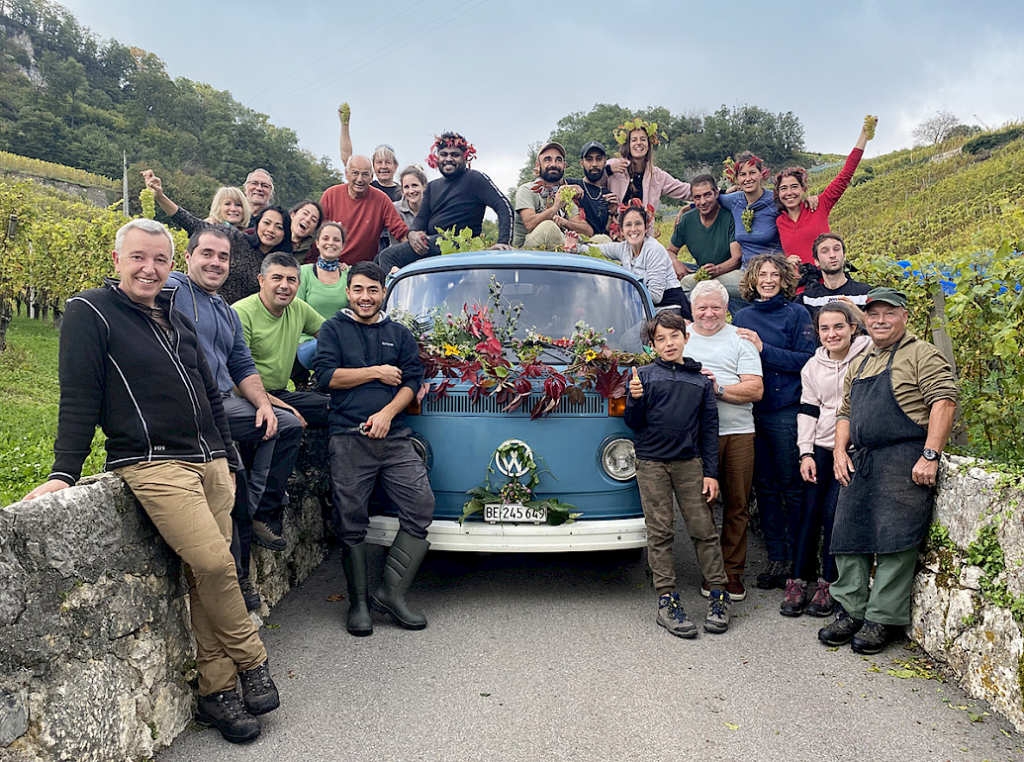
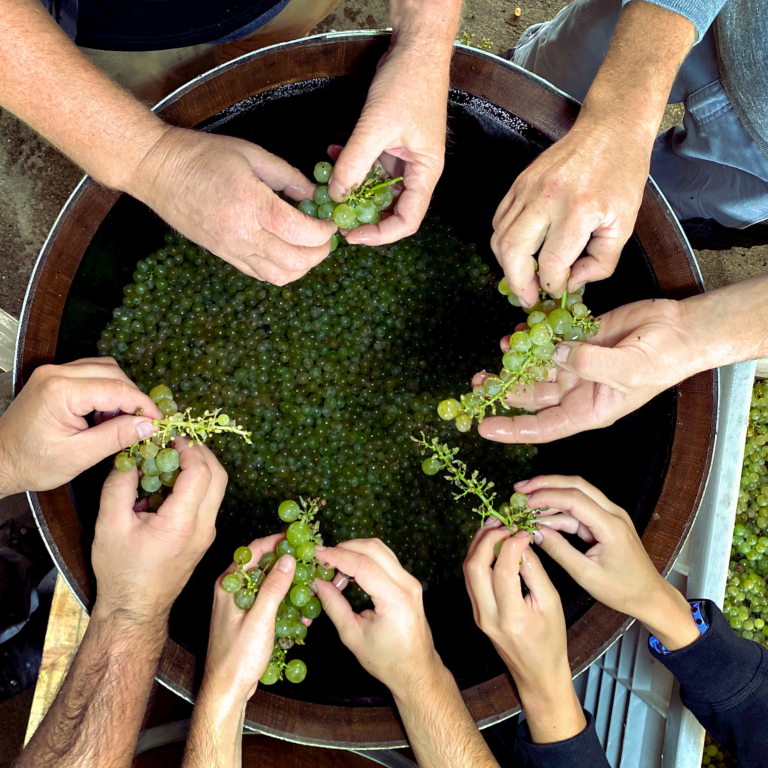
Himbo Weizen - Weidli&Bier
The weidli& beer was created in the “Weidli” high above Merligen. For 12 years, Stefan brewed beer as a hobby with a view of Lake Thun and Niesen. Yvonne always liked fermentations of all kinds and soon joined in. After a 4-month hike from Mexico to Canada and inspired by the scene there as well as the wild nature, the fermentation project “weidli&bier” was born in 2018.
Since spring 2018, special beers have been produced in small quantities in the old cheese dairy in Ringoldswil. The beers are brewed in an old milk tank with a lot of manual work and heart and soul. Weidli&bier specialise in hoppy and fruity American ales, but also love Belgian and English brewing culture and are not afraid of wild fermentation. They also like to experiment with local fruits (like berries), wild herbs or honey from the region and appreciate collaborations with other small producers.
Weidli&bier finds its greatest inspiration in untouched nature, in the art of fermentation and in the history of brewing. Fermentation After brewing hot wort, the first phase of the beer production cycle, comes a second phase called fermentation. Fermentation of wort is a manifestation of the metabolism of brewer’s yeast. The main task of brewer’s yeast in the primary fermentation stage is to convert some of the sugar in the wort into alcohol. The so-called young or green beer is pumped into another tank where the continued fermentation process is less intense but takes place at a lower temperature and higher pressure, while the beer is carbonated with carbon dioxide. The second part of the fermentation process is then called maturation of the beer – secondary fermentation. Himbo wheat Classic wheat beer refined with Swiss raspberries. The pink-coloured top-fermented beer is slightly sweet and tart. Alcohol content: 5.4 vol % Bouquet: sweet-sour and fruity, slightly woody Palate: Light, tangy and drinkable Beer and food: Goat cheese and fruity desserts

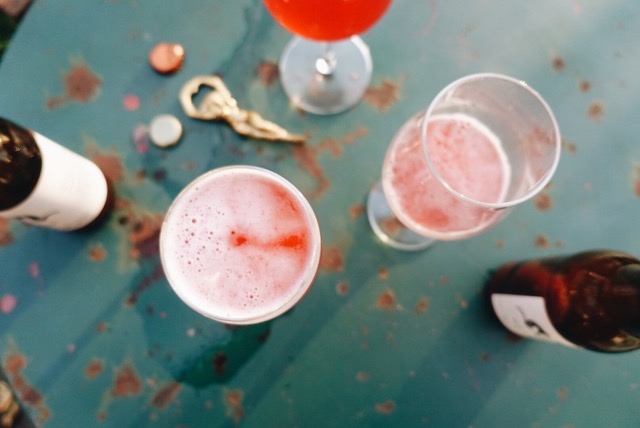
Summer Challenge 2022 Post your best Tüürli photo on Instagram and tag us. With a bit of luck, you’ll win your next Tüürli! @degustationswanderung.ch



